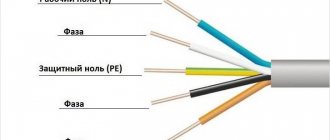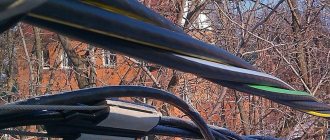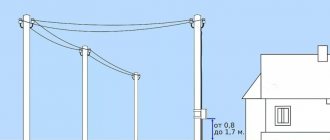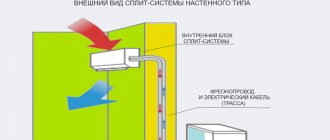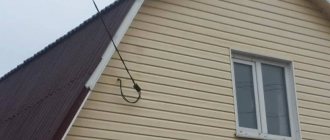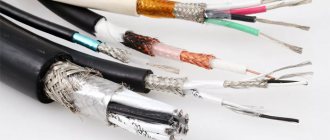Connecting a private house, cottage or any other low-rise building to electrical networks can be done in three ways: by air, in the ground or a combination. The owner himself chooses the electrification option, depending on the cost of the work, his own preferences and, of course, on the actual possibility of implementing this or that type of connection. Laying an electric wire by air is the cheapest method, but it has a number of disadvantages: there is a high possibility of cable damage due to strong winds, icing and other natural factors. In addition, theft of an expensive wire cannot be ruled out.
The option in which the cable is laid in the ground to electrify the facility does not have all these disadvantages. The cost of such work is much higher than an overhead connection, but the high financial costs are offset by the reliability of underground communications and a longer service life. If the power cable is installed correctly underground, it can last for several decades. Below we will look at all the advantages of underground installation of electrical communications, and also provide complete instructions for doing such work yourself.
Advantages of laying cables underground
As mentioned above, laying an electrical cable in a pre-dug and prepared trench has only one advantage over air supply and no disadvantages in terms of reliability. Of course, all this is valid if the installation is carried out in compliance with all the rules. Let's look at the main advantages of this method of electrifying a private house, cottage or other facility.
- The possibility of using an electrical cable of a larger cross-section, so to speak, with a reserve, without the reinforcement of the supporting structure necessary for overhead lines.
- Minimization of all external devices such as switches, isolators and so on. It is enough to install one circuit breaker at the input to completely de-energize the internal electrical network.
- The aesthetics of the general appearance of the structure is also an important advantage of this connection option. Hanging and swinging wires do not add to the overall attractiveness of the building.
- If the trench is deep enough and communications are installed correctly, you can forget about the cable forever. The possibility of its failure and subsequent replacement is practically excluded.
How to lay a cable in the ground? The technology for such work is almost the same for all regions of the Russian Federation, with some nuances for different soils and climatic conditions. It is regulated by GOSTs and standards that have remained unchanged since the 60s of the last century. Laying cables underground at a dacha, in a private house or other low-rise building begins with the development of the route.
Minimum order
Minimum order within Moscow and the Moscow region:
10,000 rub.
When connecting a residential building, industrial or commercial facility to the power supply network, it is often necessary to resort to excavation work to lay the cable from the distributor to the consumer. According to current legislation and existing rules, before starting to dig a trench for a cable, you must obtain special permission for this. Responsibility for documenting excavation work lies with the owner of the property. But even if permission has already been obtained, you need to entrust the construction of the trench to qualified excavators, since this work requires certain knowledge and responsibility of the performer.
Underground cable route design
The owner receives a plan of the route from the pole to the building along with the project for connecting to the electrical networks, but he carries out the wiring along the site to the bathhouse, garage and other objects independently. The most economical option is to lay the cable in a straight line, but in reality this is rarely feasible, since you will have to work around various obstacles. When developing a plan for laying underground cables across a site, the following rules must be followed.
- If possible, avoid intersection with other communications. If this can be done, then the cable without a protective sheath must be placed at a distance of no closer than 0.5 m from gas, water and sewer pipes. When laying the conductor in a casing, this distance is reduced to 0.25 m. When crossing with another electrical cable, this parameter is 15 cm.
- It is necessary to bypass parking areas and vehicle entry areas. If this condition cannot be met, then it is necessary to increase the depth of the trench or pass the cable through a protective case. Large trees and bushes should be avoided. When passing the route along the foundation, the distance from it must be at least 60 cm.
As a result, the cable laying plan will correspond to a broken line, not a straight line. Marking the trench is best done with a stream of sand or pegs. After the preparatory work, it is necessary to once again check the plan for compliance with the standards and transfer it to paper, linking it to all objects on the site and underground utilities.
This drawing will subsequently be useful during the construction of new facilities, redevelopment of the site, as well as in the event of a need to repair an underground power line, which can happen if the technology for laying an electric cable in the ground is not followed or in other force majeure circumstances. The plan has been developed, transferred to paper - it’s time to start the main work!
Briefly about the main thing
Underground cables are available for dry, wet and cold soil. Everyone has their own brand.
When laying, it is advisable to exclude tensile loads. There is no need to protect it with bricks if there is no kindling in that place.
The depth of the trench should be from 50 to 100 cm, depending on the placement.
There are certain standards for distance from static objects. For installation, it is necessary to make a diagram of the area so that in the future you will know where the wire is located.
The pillow must be at least 10 cm, 20 cm when entering the house. There should be no sharp objects in the ground.
In winter, the wire must first be warmed up to prevent cracks and breaks from appearing.
Underground cable installation technology
Laying an electrical cable in the ground at a summer cottage, the territory of a private household or other facility begins with excavation work. Before this, you need to decide on the depth and width of the trench. The depth must be at least 80 cm, and the width 30 cm for each cable, if there are several of them. In accordance with the developed plan and route markings, soil sampling is carried out. The trench is cleared of foreign hard and sharp objects, and its walls should have a slight slope. After excavation work is completed, the cable is laid according to the following algorithm:
- the bottom of the trench is leveled, covered with sand in a layer of 15 cm and compacted;
- Protective cases are placed on the prepared pillow, if necessary;
- the cable is pulled through the cases, maintaining the required slack;
- the protection pipes are connected into one whole in one of several ways;
- a layer of sand 25 cm thick is poured on top of the laid cable in protection;
- the top filling is slightly compacted, preferably with your own feet;
- plastic warning tape must be laid with the lettering facing up;
- the trench is filled with soil, layer by layer, with mandatory compaction.
Attention! Don't rush to bury the cable! Be sure to invite a representative of the energy company that gives permission to connect to public electrical networks. You can carry out underground laying and installation of the necessary equipment yourself, but authorized power engineers must check for compliance with GOSTs and PUE (electrical installation rules)!
It is advisable to lay the cable in one single piece, without any connections. If this option cannot be implemented, then the individual pieces must be connected in mounting boxes specially designed for outdoor use. The device is installed on a post above the soil surface, at the junction of the cable, where its ends are brought to the surface. Do not bury the box, as this will quickly damage the line.
At this point, the laying of cable lines in the ground ends and the stage of connecting underground electrical communications to the general power supply networks and input into buildings located on the site begins. Each stage of work, both when laying the cable and connecting it, has its own nuances, which will be highlighted below. We will begin this description with the choice of cable for underground routes.
Video description
How to warm up the wire in winter conditions is shown in the video:
With any of these methods, it is necessary to seal the ends of the cable using special couplings to prevent condensation from penetrating.
The cable needs to be warmed up only after the entire line has been fully prepared, since in winter the installation of the electrical network is strictly regulated in terms of timing. Installation of a warm wire must be carried out at a certain time:
- 60 minutes – from 0 to -10 °C;
- 40 minutes from -10 to -20 °C;
- 30 minutes – from -20 and below.
A cable for laying in the ground that has been heated should not be bent too much. After installation, it must be covered with a small layer of fluffy earth and wait until it cools, and then bury the hole.
If your budget allows, you can purchase a cold-resistant cable (CL). It is designed for low temperatures and is not damaged by severe frosts. This cable has its advantages: a good range of temperature conditions for installation (from +50 ° C to -60 ° C), as well as use without heating in frost conditions of -25 ° C.
Cold-resistant wireSource hostingkartinok.com
Which cable is suitable for laying in the ground?
The answer to this question is clear! It is best to use a cable of the highest protection class, preferably with a tough sheath. Such a product can be buried without protective cases, with the exception of parking areas and vehicle entry. The following brands of electrical cables correspond to these characteristics: AVBShv, VVB (moisture-resistant armored), VVBbG (armored with waterproofing), VBBShv (armored in a polyethylene hose). It should be noted that this is an expensive product and it is advisable to use it to supply electricity from a utility pole to the main building on the site.
When selecting armor, you should take into account the acidity of the soil and the presence of foreign bodies in it. Depending on these indicators, cables with aluminum, lead or steel armor are selected. Underground wiring around the site can be done using cheaper products. NYM and SIP wire brands enclosed in polyethylene pipes may also be suitable for these purposes. It is undesirable to use VVG, since their service life underground is unlikely to exceed 2 years. In terms of long-term savings, it's best to use expensive cables. Large initial investments will be compensated by a long service life!
Important! Before laying a purchased cable in a trench, it is advisable to measure the resistance of the insulating layer. This operation is performed using a megger. If you could not find such a device, then you need to at least check the product for breakdown between the wires, which can be done using a regular tester.
Video description
This video shows how to install a wire into a house:
Everything is connected to the forced disconnection device in the electrical distribution board and power line wires using special clamps. The wire can be fixed on the pole with clamps in increments of no more than 1 m.
Grounding armor wireSource i.ytimg.com
Protection of underground electrical lines
To protect the cable, you can use a special corrugated plastic protective sheath, asbestos-cement or PET water pipes. Sewer pipes should not be used, as they have thin walls that cannot provide protection from heavy loads. It is also not recommended to lay the cable in steel pipes. To ensure reliability, when the ground moves, they must be welded along the entire length, otherwise the sharp edges may fray the wire. It should be said that armored products do not need such protection, but many consumers use protective cases for such products.
If pipe cases are used on an underground cable route, the joints must be properly sealed to prevent water and soil from entering the internal cavity. For these purposes, you can use masonry mortar, rags soaked in cement milk, or special sealants. Who likes what! You just need to remember that the cable in the case must have a certain slack, that is, it should not be pulled. That's about all there is to say about cable sheaths.
In addition, underground electrical lines must be shielded from above. Such protection eliminates the possibility of damage to communications during various construction and earthworks. For lines with voltages up to 380 V, plastic signal tapes or a brick row are used. Lay the protection to a depth of 25 cm from the soil surface. For high-voltage underground cable lines, concrete slabs are used, laid using appropriate technology on special supporting structures.
Important! The method of laying a cable electric line underground in a protective sheath has one significant advantage: if the cable fails, there is no need to dig a trench; it is easiest to tighten it into a protective case. A new cable is tied to the faulty one and pulled out, thereby replacing it with a working product. But this is only possible if the integrity of the protective case is not compromised!
Criteria for choosing wisely
The key to uninterrupted operation of the home electrical system is the quality of components.
Therefore, at the stage of purchasing them, one of the key tasks is to choose a cable of appropriate quality. Manufacturers always indicate what metals the cores are made of and what materials are included in the insulation braid; these parameters are indicated in the cable marking
To help you choose the right cable, you need to carefully study the product labeling. The cable must indicate: brand, manufacturer's name and compliance with GOST or technical specifications. The cross-sectional size and grade of the cable must be repeated at equal intervals along the entire length of the outer braid of the product.
The marking of any electrical cable is represented by numbers and three letters.
The first digit of the numerical designation determines the number of cores, the second digit – the cross-sectional area of each of them, the third – the calculated network voltage. The remaining numbers indicate the flexibility class of the cord. The first letter determines the type of material used to create the top braid of the insulation.
If you have a product in front of you that has the letter “A” in the first place in its marking, this means that the cores are made of silver metal – aluminum; if such a letter is missing, the threads are made of copper
The second letter indicates the wire type:
- “K” – control;
- “P” – flat;
- “M” – installation;
- “Ш” or “У” – installation;
- “Mg” – mounting with flexible core.
The third letter of the marking determines the material used for internal insulation of the cores.
Options for its designation and decoding:
- “P” – insulation is made of polyethylene;
- “B” or “BP” – the braid is made of rubber;
- “Pv” – vulcanizing polyethylene is used;
- “Ps” – self-extinguishing polyethylene was used;
- “C” – the outer braid is made of lead;
Rubber insulation can be protected by a Nairite “N” sheath or a polyvinyl chloride “B” sheath.
An example of decoding the designation: VVG 4x2.5-380 - a cable with four copper cores with a cross-sectional area of 2.5 mm, designed for a voltage of 380 V, insulated with PVC braiding and enclosed in an outer PVC sheath
The following letter indicates the type of cable: “NG” - non-flammable and fire-resistant, “B” - armored, “LS” - does not emit smoke when melted. Products with an armored shell are used where there is a possibility of mechanical damage.
The presence of the letter “E” in the marking indicates that there is filler between the cores. The letter combination “OZH” indicates that this is a single-wire conductor.
Entering the cable into the house and connecting to the pole
Entering an underground electrical line into a building can be done in various ways, but the PUE prohibits laying it directly through the foundation, without the use of additional structural elements. The following methods are available for connecting indoor wiring to underground cable.
- In a building with a basement, a hole is punched in the foundation and a piece of metal pipe of the appropriate diameter is walled into it. The length of the pipe should be slightly greater than the thickness of the foundation. The cable is pulled through it, and the internal space of the structure is filled with a sealing substance: cement mortar, polyurethane foam, and so on.
- At the entry point, a metal pipe is installed, bent in two places with the appropriate dimensions. An electrical cable is passed through this structure and brought into the house through the external wall at the required height. The bending radius of the pipe must be at least 10 of its outer diameters, which is necessary to avoid damage to the conductor.
- A shallow foundation can be bypassed by laying a line under it at a depth of 50 cm from the bottom edge, after laying a metal pipe and passing a cable through it. Entry is through the floor of the building. With a pile foundation everything is much simpler. A trench is laid to the entry point, a hole is punched in the ceiling and the line is brought into the house.
Connecting underground cable lines to a power pole will not cause any difficulties. Power engineers do not have any special requirements for this stage of underground cable laying. The upper part of the connection area, from the electrical wires to the equipment panel, should be enclosed in a corrugated plastic pipe, and the lower part is at the discretion of the user. Of course, it is advisable to pass it through a curved metal pipe to prevent accidental damage, but according to the PUE standards this is not a mandatory requirement.
How to choose the right section and brand of SIP
So what kind of cable should be used to bring electricity into the house? Many people resort to using SIP cable; it is allowed in many electrical industries and even in high voltage lines up to 35 kW.
This cable has its own design feature - phase wires, most often in the amount of three, wrap around the fourth - zero. Therefore, the appearance of SIP resembles a rope twisted into a spiral. High-quality LDPE or XLPE polyethylene is used to insulate conductors. These types of materials have high resistance and a long service life, which allows them to be used even with sudden temperature changes.
The core, which is located in the middle and has zero potential, is made of aluminum alloy. Sometimes the zero does not have its own insulation, which is required for phase conductors.
The SIP cable has one serious drawback - due to the presence of insulation, the cable is insufficiently cooled, so the current loads allowed are lower than those of uninsulated conductors
When choosing SIP, you should pay attention to insulation:
- With insulation made of thermoplastic polyethylene, temperature loads of up to 70 degrees are allowed. Suitable for this parameter: SIP-1, SIP-1A, SIP-4, SIPn-4.
- When choosing cross-linked polyethylene as an insulating material, temperature loads of up to 90 degrees are allowed. Overload mode indicators and short circuit current parameters also increase. Such performance characteristics have: SIP-2, SIP-2A, SIPs-4, SIP-3, PEV and PEVG.
The SIP cross-section is also determined by power consumption, the formula is presented above.
Practical advice from experts
In addition to the above instructions, we recommend that you familiarize yourself with some tips regarding laying cables in a trench:
- Use only a special armored conductor. Brands such as , PUNP, ShVVP or PVS cannot be used, because they do not have sufficient protection.
- The diameter of the metal pipe that will pass through the foundation of a private house (if necessary) should be 3 times larger than the diameter of the electric pipe itself. cable.
- If the depth of soil freezing in your region is deeper than 70 cm (trench depth), be sure to secure the protective pipe so that it does not break or become deformed.
- The use of plastic corrugated pipe to protect electrical wiring underground is prohibited. Within a year, the corrugation will collapse and all its protective properties, which are already weak, will disappear.
- Try not to lay the conductor under high-traffic areas such as roads, parking lots and driveways. If this is unavoidable, do not forget about laying in pipes and protecting with bricks.
- There is no consensus or rules in regulatory documentation regarding the minimum cable cross-section for laying in the ground. In practice, the most often used cross-section is 10 mm2 for copper and 16 for aluminum. Focus only on calculating the cable cross-section for power and current, and also keep in mind that the line must be armored.
Review of the work done
Lump connection
For installation, it is better to use a solid cable, but if it is not possible to find a piece of wire of the required length, it is better to connect the two wires on the surface of the ground, inside a sealed junction box. Such a connection is easy to maintain and, if necessary, rework. It is not recommended to place it in a homemade coupling and bury it in the ground - the contact will quickly be broken, and to restore it the trench will have to be dug out each time.
For comparison, the video shows the production of a full-fledged coupling that can be hidden underground:




